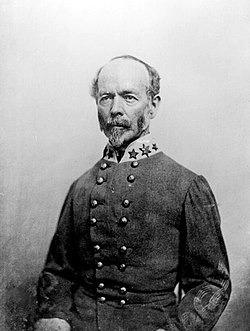Army of the Shenandoah (Confederate)
| Army of the Shenandoah | |
|---|---|

Joseph E. Johnston
|
|
| Active | May 1861 – July 1861 |
| Country |
|
| Branch |
|
| Type | Field army |
| Role | Confederate army in Eastern Theater |
| Engagements |
Battle of Hoke's Run First Battle of Bull Run |
| Commanders | |
| Notable commanders |
Joseph E. Johnston |
The Army of the Shenandoah was an army of the Confederate States of America during the American Civil War; it was organized to defend the Shenandoah Valley of Virginia in the early months of the war. The army was transferred to reinforce the Confederate Army of the Potomac at the First Battle of Bull Run, which was its only major action. After the battle, the army was merged into the Army of the Potomac.
The Army of the Shenandoah originated with the various militia and volunteer companies sent to seize and defend the town of Harpers Ferry, Virginia (modern day West Virginia). To organize and train the companies, Virginia state commander Robert E. Lee initially appointed Thomas J. Jackson to command the post. Jackson formed five regiments of infantry and a battery of artillery from the various companies, forming the basis of the Stonewall Brigade. On May 15, Joseph E. Johnston replaced Jackson as commander of Harpers Ferry and continued to receive additional regiments from throughout the Confederacy. He would eventually have four brigades of infantry and an independent regiment of cavalry, the 1st Virginia Cavalry commanded by J. E. B. Stuart.
In mid-June, forces from the Union Department of Pennsylvania commanded by Robert Patterson began moving south towards Harpers Ferry. Fearing that the terrain around the town made it indefensible, Johnston had the bridges and as much equipment in the town as possible destroyed and retreated south to Winchester; Patterson remained along the Potomac River rather than pursue Johnston. Over the next few weeks, both forces watched each other, only engaging in battle once at Falling Waters on July 2. After spending almost two weeks waiting on the Potomac and receiving reinforcements, Patterson started advancing towards Winchester but had moved only 5 miles (8.0 km) before encountering Stuart's regiment screening Johnston's army. Patterson halted again and consulted his officers, who advised caution; this advice, along with the refusal of several regiments which were due for mustering out to remain any longer, convinced Patterson to cancel the advance. This allowed Johnston to follow orders he received on July 18 to transfer his army to reinforce P. G. T. Beauregard's Army of the Potomac at Manassas Junction. The movement started that evening, with each brigade marching to Piedmont where it boarded a train for Manassas Junction. Since there was only one train on the Manassas Gap Railroad, the brigades arrived one at a time; the artillery and cavalry marched overland. The final units of Johnston's army arrived on the afternoon of July 21.
...
Wikipedia
